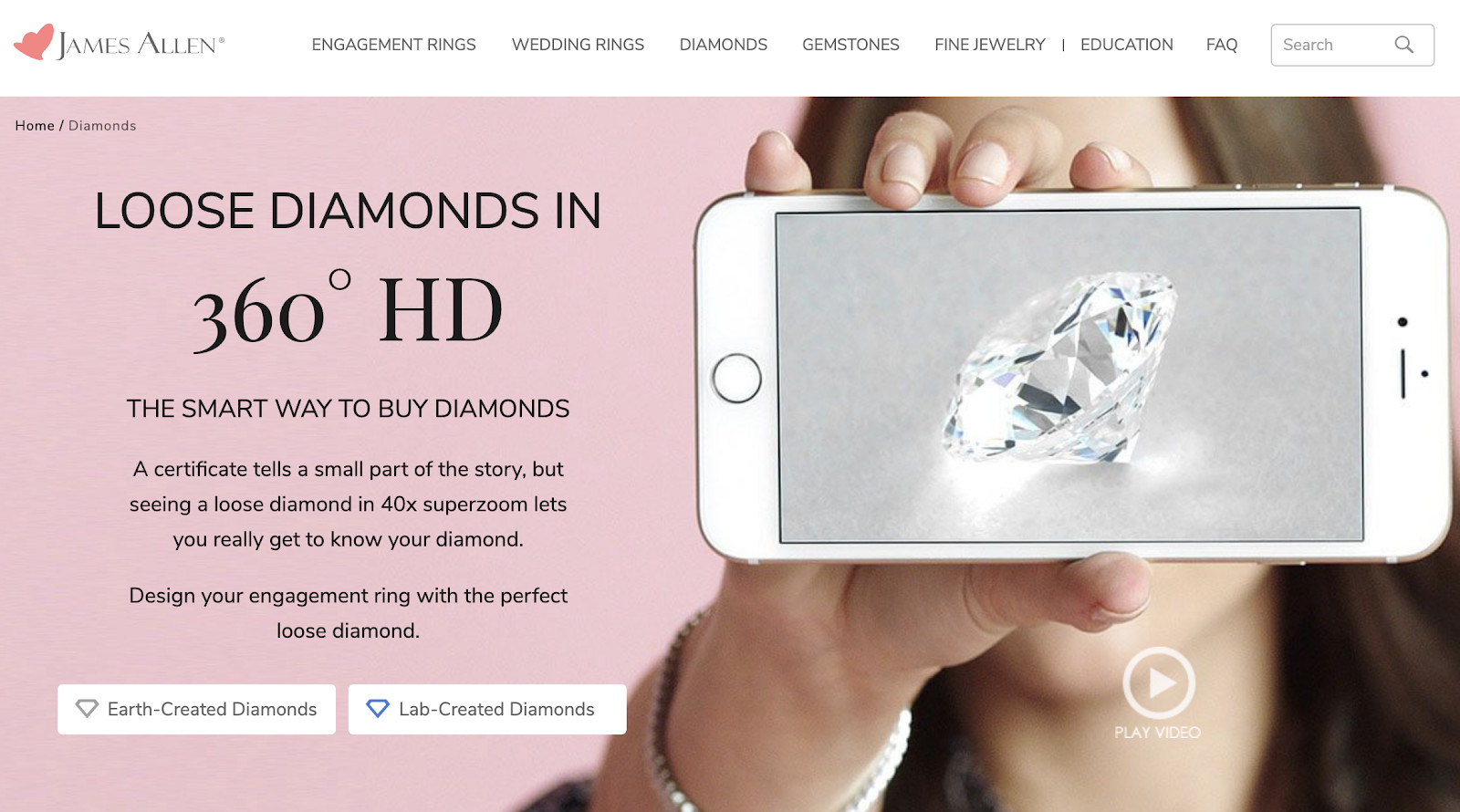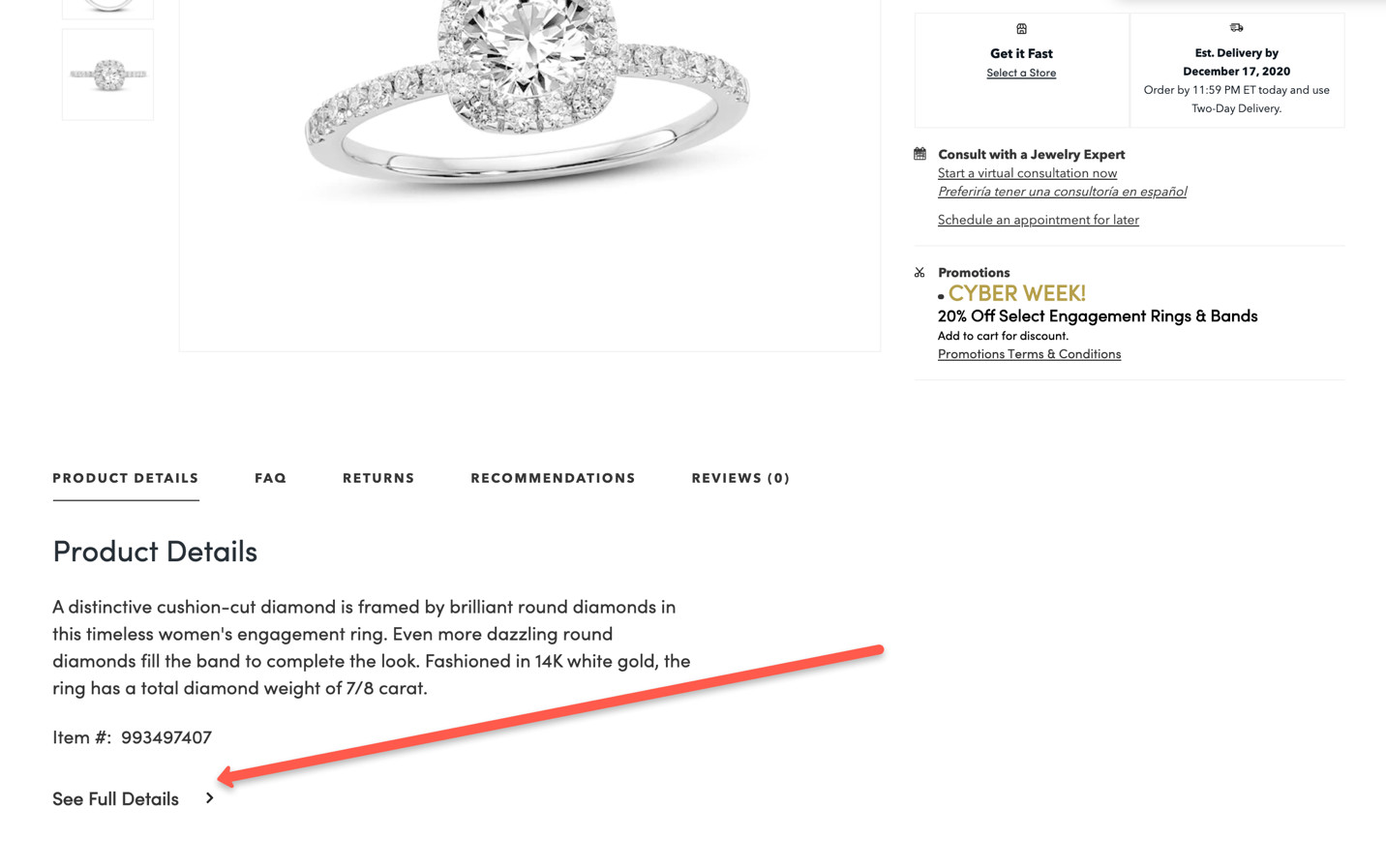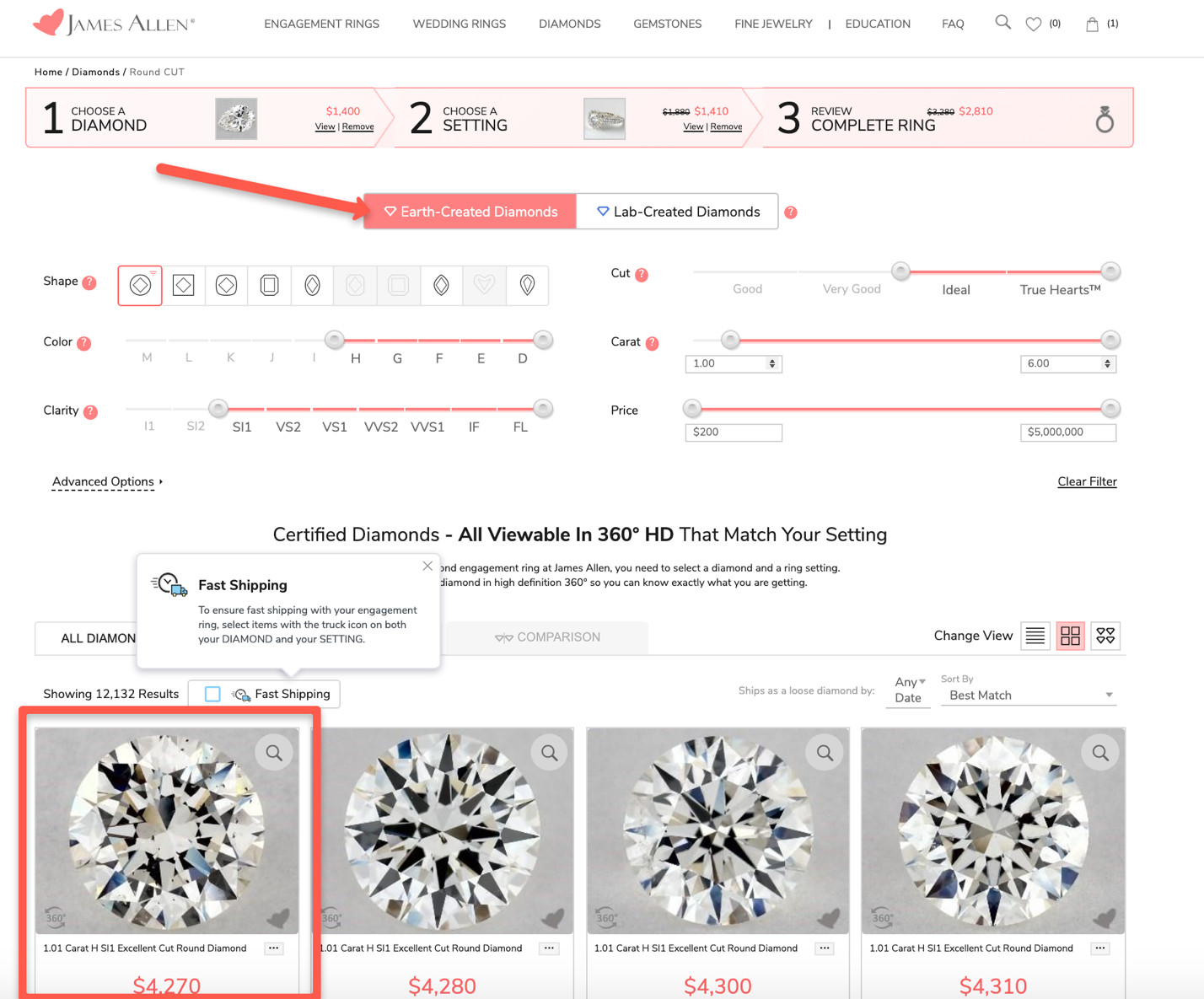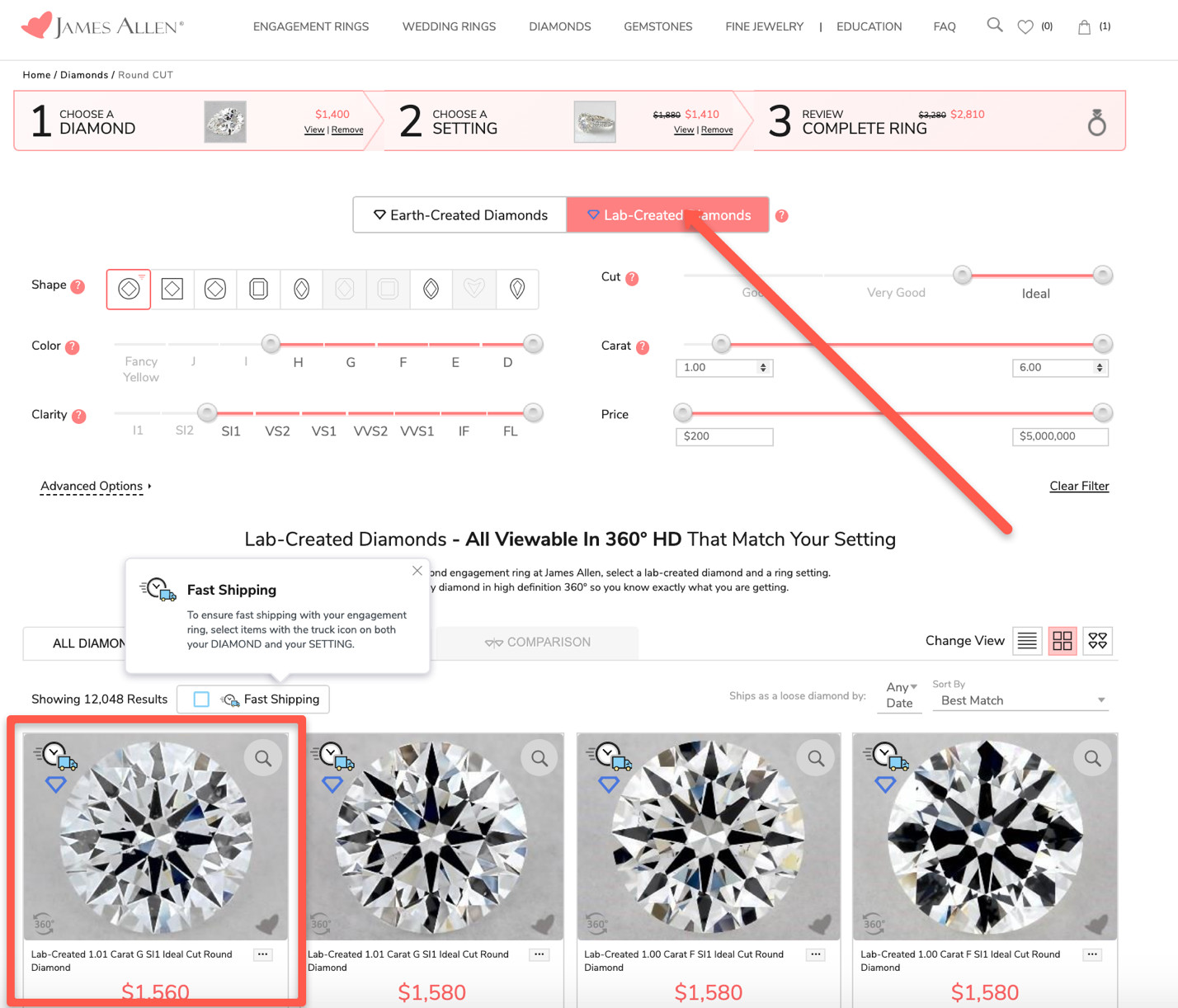If you’re thinking about buying an engagement ring or other diamond jewelry, you should take a moment to learn about synthetic diamonds.
Synthetic diamonds may have the impression of being lower quality than natural diamonds but that’s simply not the case. They are created just like natural diamonds but in a lab instead of in the earth. Because of this, you can often get a higher quality diamond for less cost.
Table of Contents
What is a Synthetic Diamond?
“Synthetic” is a term used for diamonds that are more aptly called lab-grown or lab-created diamonds.
All of these names refer to diamonds that are man-made in a laboratory rather than mined from the earth.
Are they authentic diamonds?
The short answer is yes! Synthetic diamonds are physically the same as earth-mined diamonds. The only difference is their origin. They are synthesized in a manufacturing lab instead of created deep inside the earth’s crust.
Synthetic diamonds look exactly like earth-created diamonds. In fact, lab-grown diamonds are chemically identical to earth-created diamonds.
Let me say it again: Synthetic diamonds are not just like earth-created diamonds. They are exactly the same substance. They’re indistinguishable from earth-created diamonds because they are diamonds. In fact, even jewelers sometimes can’t tell the difference.
They are so much “like” earth-created diamonds that they are officially graded by major diamond grading labs such as the International Gemological Institute (IGI).
Despite all of this, synthetic diamonds can be quite a bit less expensive than earth-made diamonds. Why? I’ll reveal that soon. (And you’ll love the answer.)
How are Synthetic Diamonds Made?
Synthetic diamonds are created in industrial laboratories using extreme pressure and high temperature – the same forces that create natural diamonds deep within the earth. Here’s a good video that explains the process.
Scientists “seed” the diamond with a tiny, minuscule chip of an existing diamond. Then they lay carbon atoms over it at high pressure and high temperature.
The carbon atoms crystallize around the diamond seed and form a new, larger rough diamond.
Growing diamonds in a lab is not unlike growing salt crystals. It’s just more intense. The diamond rock which results from the industrial lab procedures is just like a diamond rock mined from the earth.
The rough diamond is sent to a diamond cutter, who cuts and polishes it into a finished gemstone – just as they do for earth-mined diamonds.
The end result is a jewelry-quality gemstone that is indistinguishable from a diamond mined from the earth. A diamond grown in a laboratory may be synthetic, but it’s not fake.
Here’s an analogy to drive home the point.
Consider steam.
There are geysers like Old Faithful in Yellowstone National Park where steam rises naturally from the earth.
Yet you can also create steam on your kitchen stovetop by boiling water. Or in your bathroom when you take a hot shower.
Is the steam that comes out of your kettle any different than the steam coming out of Old Faithful? Not a bit.
You can consider the “earth-created” steam – the steam rising out of a geyser – to be like an earth-created diamond.
Then you have “kitchen-created” steam. That’s like the steam off of the pot of water over your burner.
The steam created by the pot of water over the gas burner is 100% authentic steam – just like that from the geyser. In the same way, synthetic diamonds are 100% the same as earth-created diamonds other than how they were created.
How are Synthetic Diamonds Distinguished in the Market?
If synthetic diamonds (lab-grown) diamonds are identical in substance to natural diamonds, how do you know which type of diamond you’re buying?
First of all, the chances that you would buy a synthetic diamond from a reputable jeweler without realizing it are close to nil.
Earth-created and lab-created diamonds are treated very differently in the marketplace.
Many people do not even know about lab-grown diamonds. And even more shoppers do not fully understand them and are, therefore, uncomfortable buying them. As a result, there is less demand for synthetic diamonds. And this can result in lower prices.
Keep in mind, too, that what you may have heard about the diamond industry propping up diamond prices is true. Diamonds are not as scarce as we are led to believe. Enough diamonds exist to make them very cheap. But the industry is a cartel that artificially constrains supply to keep prices high. Sort of like how OPEC and other oil-producing countries slow down their production of oil when the price becomes too low to be profitable.
How does this affect the prices of synthetic diamonds?
Well, the major players in producing synthetic diamonds are different. They’re more like tech industry disruptors than traditional diamond companies such as De Beers. They aren’t as successful at limiting the supply of synthetic diamonds. And they probably aren’t as interested in that.
Boiled down, the fact is this: not only is there less demand for synthetic diamonds, there is also more supply of them than earth-mined diamonds. The result? Synthetic diamonds are cheaper.
And that’s a huge motivation for everyone in the diamond business – from mines to wholesalers to retailers – to keep the two markets distinct. So, they label lab-created very strictly. And they make sure that the two markets are distinct in consumers’ minds.
Consumers are equally interested in keeping the two markets separated by labels.
We all want to know: Is it a diamond earth-created or lab-created? Some people love the romance of a 3-billion-year-old stone, understandably.
Others, meanwhile, prefer to know that their jewelry was created in the most environmentally-friendly and politically-fair method possible. (No lab-grown diamond was ever a blood diamond.)
Labels for Synthetic Diamonds
Every reputable jeweler will label synthetic diamonds as “lab-created” or “lab-grown”. (Same meanings.) They’re documented, tracked and graded separately. Many are even laser-inscribed at a microscopic level.
If you want to know whether a given diamond is lab-created or earth-created, just check the label. With good jewelers, there shouldn’t be any question. For example, the online jeweler James Allen completely segregates the two categories of diamonds. Look at the screenshot below – you either shop for one or the other.

If your jeweler is not making it abundantly clear which type of diamond you’re looking at, be careful! I regret to say that some famous brick-and-mortar retailers (I won’t name names) tend to hide some details about their diamonds in the small print of a website product page.
See the below image of a diamond for sale on a major jeweler’s website. This happens to be a poor-quality diamond – they’re just hoping you don’t notice!

This could be accidental. I’m not accusing anyone. But in the end, whether it’s accidental or deliberate doesn’t matter, from the point of view of a consumer advocate.
The information is still less than 100-percent transparent. I’ve not seen them hide details about whether a diamond is lab-created or earth-created. But I often see some retailers put very important details into the fine print. Such as I3-Clarity.
HowLab-Created Diamonds Can Save You Money
The only reason lab-created diamonds are less expensive than earth-created diamonds? Market forces.
That’s driven almost exclusively by people feeling skittish or skeptical or uneasy about buying lab-created diamonds.
It’s understandable. Most people shopping for a diamond are new to it. And they may buy a diamond ring only once or twice in their lives.
So, they tend to go with the safe choice, in their eyes: earth-created diamonds. And that is a safe choice if you’re also aware of the 4Cs of diamonds and how they affect a gem’s quality and value.
But there’s nothing wrong with going with synthetic diamonds. But the 4Cs and the stone’s quality is equally as important. There’s virtually no difference in how the two types of diamonds are graded and valued. There’s one interesting exception, which I explain in the next section.
When couples who are new to diamond shopping consider their choices, they tend to shy away from synthetic diamonds:
- Synthetic diamonds can seem less romantic, because they didn’t form deep in the earth 3-billion years ago
- Synthetic diamonds can seem iffy to the uninformed.
- Synthetic diamonds can seem less romantic because they’re less expensive.
But what about well-informed, open-minded couples?
Do you see the advantages for the open-minded couple who are willing to be “early adopters” of technology?
If you and your fiancée understand that synthetic diamonds are fully authentic, identical to earth-created diamonds, and if you can see them as romantic, then you can get a higher quality diamond for much less.
Synthetic diamonds tend to have better color and clarity
Lab-created diamonds are subject to all the same kinds of inclusions (flaws) as earth-created diamonds. Just because they’re made by engineers doesn’t mean they are perfect diamonds. The process doesn’t work that way.
But because the conditions in the lab are more controlled than conditions deep in the earth 3 billion years ago, the diamonds coming out of labs tend to be of better quality, taken altogether.
Engineers are always improving their methods of creating diamonds, too.
You will especially find much better color in synthetic diamonds. You can even find some F-, E-, and even D-color (the highest color grade possible) synthetic diamonds that are within range of an average middle-class income. Regardless of size, such colorless earth-created diamonds tend to be very expensive!
The same general rule holds for their clarity. More controlled conditions mean in general, better clarity among synthetic diamonds, as a group.
Here’s our full guide to shopping for a diamond online.
Synthetic Diamonds vs Lab-Grown Prices Differences
You can explore the dramatic price differences in synthetic diamonds compared to earth-created diamonds by going to James Allen right now.

1.01 Carat H SI1 Excellent Cut Round Diamond (Earth-created) on sale for $4,270 at James Allen.
You’ll find a big button near the top of their diamond search engine. Choose lab-created diamonds to search only synthetic gems.

Carat G SI1 Excellent Cut Round Diamond (lab-created) on sale for $1,560 at James Allen.
Notice that the synthetic diamond’s color is actually one grade better. Everything else is the same.
But it’s significantly less expensive. That’s just one little example. You’ll find thousands of examples like that. You can save thousands of dollars and end up with a better-quality diamond!
One Word of Caution
Use strict common sense, as always, when diamond shopping. Shop only from reputable retailers. (And watch the details closely, too.)
Some are not completely transparent about specs. James Allen is very transparent as is Blue Nile. But with some other retailers, you have to dig around fine print to view even basic details such as clarity scores.
But the main point of caution for this article is: if you’re shopping for a synthetic diamond at a less-than-totally-transparent retailer (just don’t, but if you do), then make sure that you’re getting a lab-created diamond. A real synthetic diamond. Not a diamond “substitute” such as cubic zirconia. Unfortunately, there have been known cases of retailers selling actual fake diamonds and passing them off as synthetic diamonds.
I hate that I have to say that in an article extolling the virtues of synthetic diamonds, which are after all 100% authentic. But if there’s a way to take advantage of an inexperienced shopper in an expensive market like diamonds, some unscrupulous retailers will do that.
So, stick to trusted retailers such as James Allen and Blue Nile, and you’ll be fine.
Here are our full reviews of James Allen and Blue Nile.
Conclusion
You can save hundreds, even thousands, of dollars by choosing synthetic diamonds. They’re 100% authentic. They’re even graded by major labs such as the IGI.
Just be sure to use the same common sense and best practices as when shopping for any diamond. Evaluate the 4Cs. Insist on a certificate. Do business only with established, highly-reputable transparent retailers who make all the information about a diamond easily available on the page.
What might you do with the money you save on a synthetic diamond? A bigger, better honeymoon? A down payment on a car? A home improvement? A bigger IRA contribution?
Shop for engagement rings now at James Allen or Blue Nile. Not sure what to budget? Learn more about how much to spend on an engagement ring.



